Banaras, also known as Varanasi or Kashi, is one of India’s most iconic cities. It is a place where history, culture, and spirituality come together on the banks of the Ganges. Visitors to Banaras can experience its rich heritage through its stunning temples, vibrant festivals, and bustling markets. Known as the world’s oldest living city, Banaras offers a unique glimpse into ancient Indian traditions and customs.
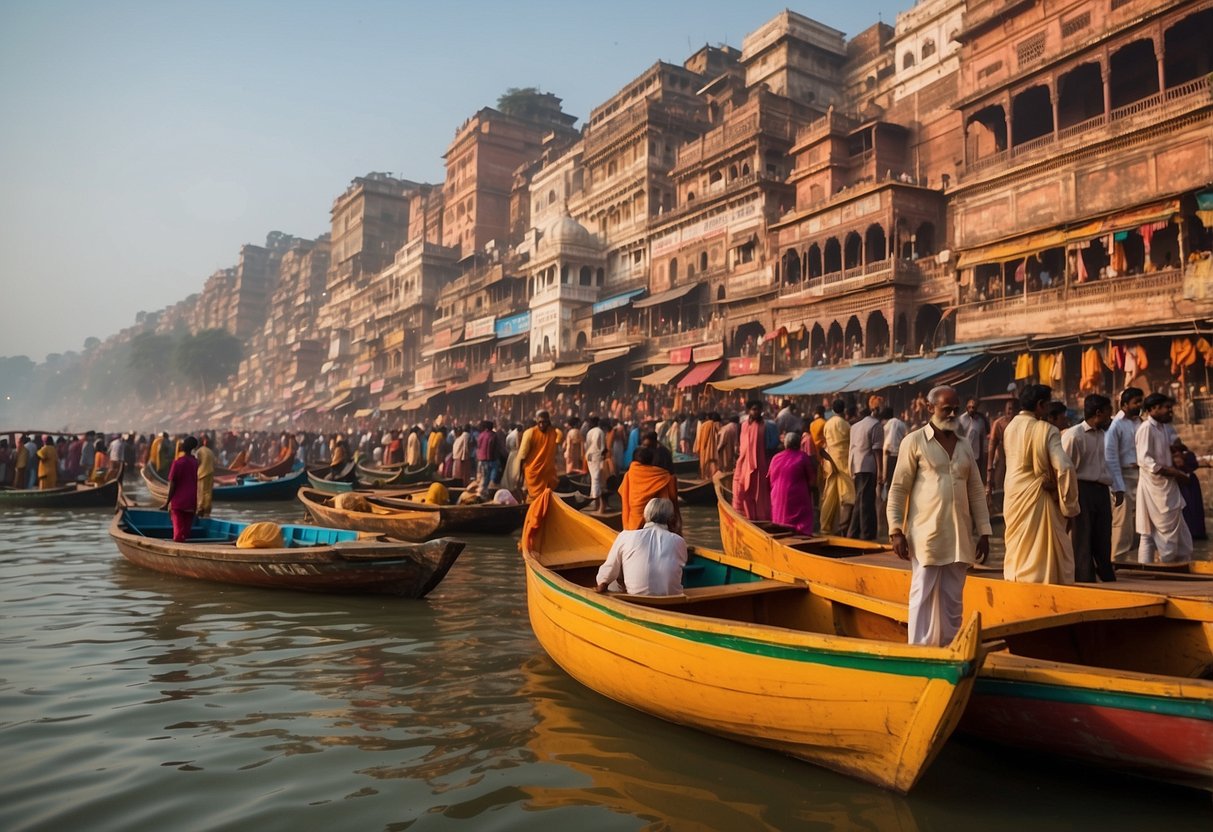
Tourists flock to the city for its numerous ghats, where pilgrims perform ritual baths and the famous Ganga Aarti takes place. The ghats are not just steps to the river; they are vibrant, spiritual spaces that attract both locals and tourists alike. In addition to spiritual experiences, Banaras is also home to many historical sites and museums that showcase its rich past.
Exploring Banaras includes visiting major landmarks such as the Kashi Vishwanath Temple, Dashashwamedh Ghat, and the bustling markets that offer local crafts and cuisine. Those looking to make the most of their visit should not miss the mesmerizing sunrise boat trips on the Ganges and the captivating evening aarti ceremonies. For more detailed information, check out the top 10 places to visit in Banaras.
Historical Significance
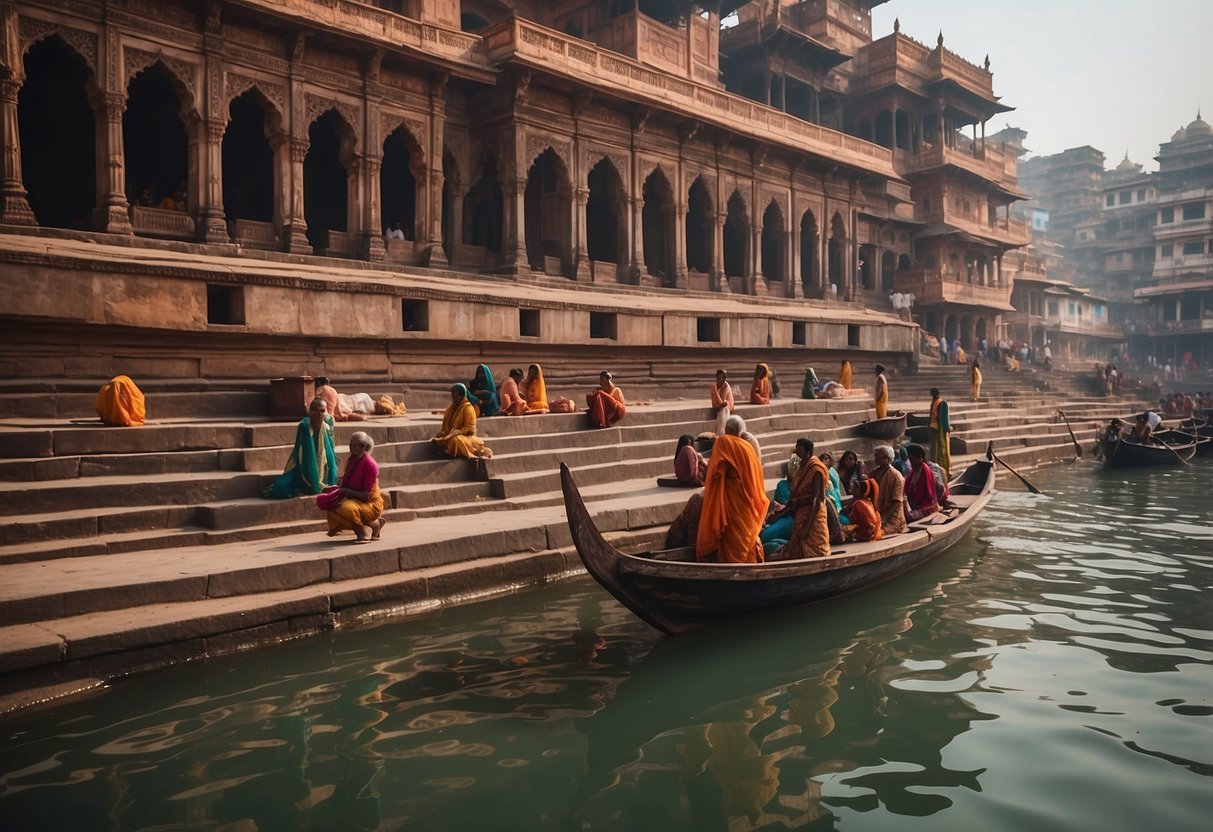
Banaras, also known as Varanasi or Kashi, holds immense historical significance. Its evolution, association with mythological figures like Lord Shiva, and rich religious heritage define it as a crucial cultural hub in India.
Origins and Evolution
Banaras is one of the oldest inhabited cities worldwide, with history stretching back over 3000 years. The city began as a center for the Vedic religion and philosophy. By the 2nd millennium BCE, it had evolved into a major urban settlement along the Ganges, known for its muslin and silk fabrics, perfumes, and ivory works.
The city’s strategic location on the Ganges made it a prominent commercial and industrial hub. Over centuries, Banaras witnessed the rise and fall of various dynasties, each contributing to its rich cultural fabric.
Mythology and Religion
Mythologically, Banaras is deeply rooted in Hindu beliefs. It is believed that the city was established by Lord Shiva, infusing it with divine energy. The city is mentioned in ancient texts like the Rigveda, marking it as a sacred pilgrimage site.
Hindus believe that dying in Banaras ensures moksha, or liberation from the cycle of rebirth. Additionally, the city is significant in Buddhism, as Buddha is said to have given his first sermon nearby. The spiritual essence of Banaras is reflected in its numerous temples, ghats, and rituals practiced by devotees.
Colonial and Modern History
During the 16th century, under Mughal Emperor Akbar, the cultural significance of Banaras was enhanced through the construction of new temples dedicated to Lord Shiva and Vishnu. The 18th century saw the rise of tourism in the city.
In modern times, Banaras continues to thrive as a spiritual and cultural center. Its heritage, marked by ancient art and architecture, attracts millions of visitors annually. The syncretic traditions blending Hindu and Islamic influences showcase the city’s diverse cultural history. Banaras remains a testament to India’s rich and enduring legacy.
Spiritual Hub
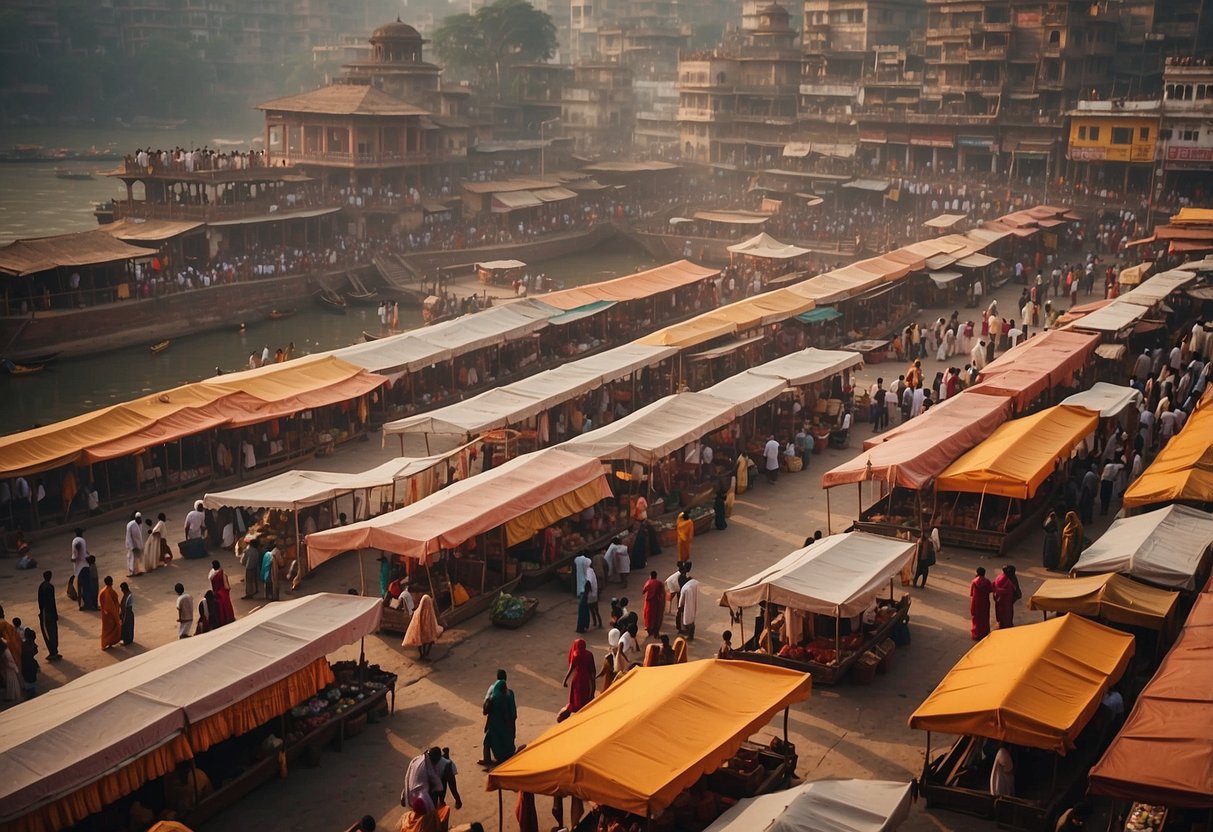
Varanasi, also known as Banaras and Kashi, is one of the most important spiritual destinations in India. Its cultural significance is deeply rooted in Hinduism, with ancient temples and daily rituals drawing millions of pilgrims.
Kashi Vishwanath Temple
The Kashi Vishwanath Temple is dedicated to Lord Shiva and is one of the twelve Jyotirlingas, representing the supreme form of Shiva. It holds immense spiritual importance as worshipping here is believed to absolve one of sins and lead to salvation. The temple is situated on the western bank of the River Ganges. Its golden spire and intricate architecture are notable features. Devotees often perform rituals such as offering milk or flowers, believing these acts bring them closer to divine blessings.
Daily Rituals and Ceremonies
In Varanasi, rituals and ceremonies occur from dawn to dusk. One of the most renowned ceremonies is the Ganga Aarti, held every evening on the ghats of the River Ganges. Priests perform the Aarti with chants, fire, and incense, creating a mesmerizing atmosphere. Early mornings see rituals like the bath in the Ganges, believed to purify the body and soul. Many also participate in Shraadha rituals to honor their ancestors. These daily practices underscore the city’s spiritual rhythm and connect followers to ancient traditions.
Philosophy and Dharma
The philosophy of Varanasi is deeply connected to Hindu beliefs in karma, dharma, and moksha (salvation). The city is regarded as a microcosm of Hinduism, where life and death are part of a continuous cycle. Sarnath, located nearby, is significant for Buddhism where Buddha gave his first sermon. This convergence of philosophies makes Varanasi a unique spiritual education center, where seekers come to understand complex concepts like dharma and righteousness. It also highlights the importance of leading a life aligned with spiritual laws to attain liberation from the cycle of rebirth.
This focus on spirituality, rituals, and philosophy makes Varanasi not just a city, but a profound journey into the heart of Hindu beliefs and practices.
Cultural Landscape
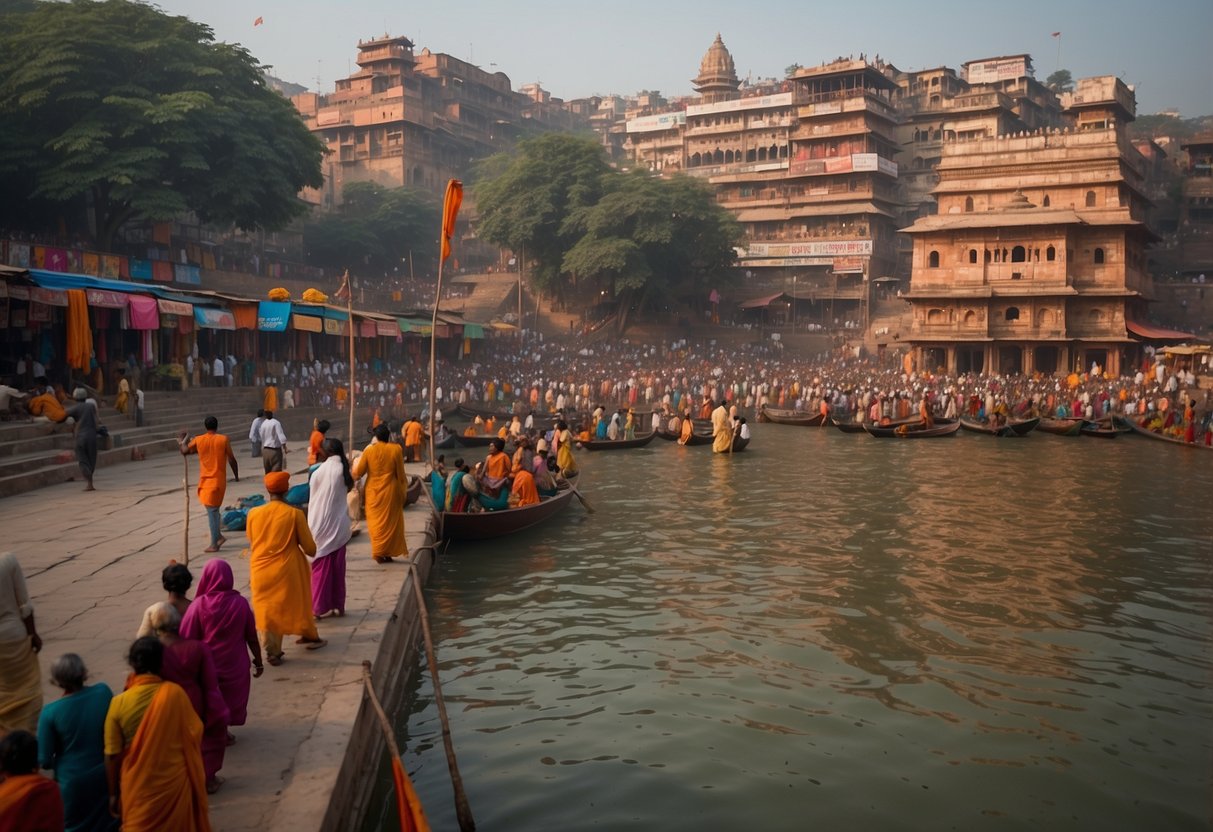
Banaras, also known as Varanasi, is a city rich in culture and tradition, featuring vibrant festivals, intricate art forms, and diverse culinary offerings. Visitors can experience the essence of Banaras through its food, music, dance, and celebrations.
Culinary Delights
Banaras offers a wide array of delicious foods that reflect its rich cultural heritage. Among the most famous are the kachaudi, a savory stuffed pastry, and the refreshing lassi, a traditional yogurt drink, often spiced with fruits or served plain.
Another popular beverage is thandai, especially enjoyed during the festival of Holi. This milk-based drink is made with almonds, saffron, and various spices. Street food vendors along the ghats and throughout the city provide locals and tourists alike with a taste of Banaras.
Music and Dance
Music and dance are integral to the cultural landscape of Banaras. The city is home to several classical music schools and has produced many renowned artists. The Banaras Gharana is a prominent style of Indian classical music known for its unique performance practices and distinctive techniques.
Dance forms like Kathak are also deep-rooted in Banaras. This classical dance style is characterized by intricate footwork and expressive gestures, often accompanied by live music. Performances can be seen at cultural events and festivals, providing a glimpse into the traditional arts of the region.
Festivals and Celebrations
Festivals in Banaras are colorful and lively, reflecting the city’s spiritual and cultural ethos. Major celebrations such as Holi and Diwali draw large crowds and feature vibrant activities. The Ganga Aarti at the ghats is a daily event where priests perform rituals with fire and chants, creating a mesmerizing atmosphere.
During these festivals, the ghats are illuminated, music fills the air, and the city comes alive with joy and devotion. These events offer an immersive experience into the cultural richness and spirituality of Banaras, making them a highlight for any visitor.
Architecture and Arts
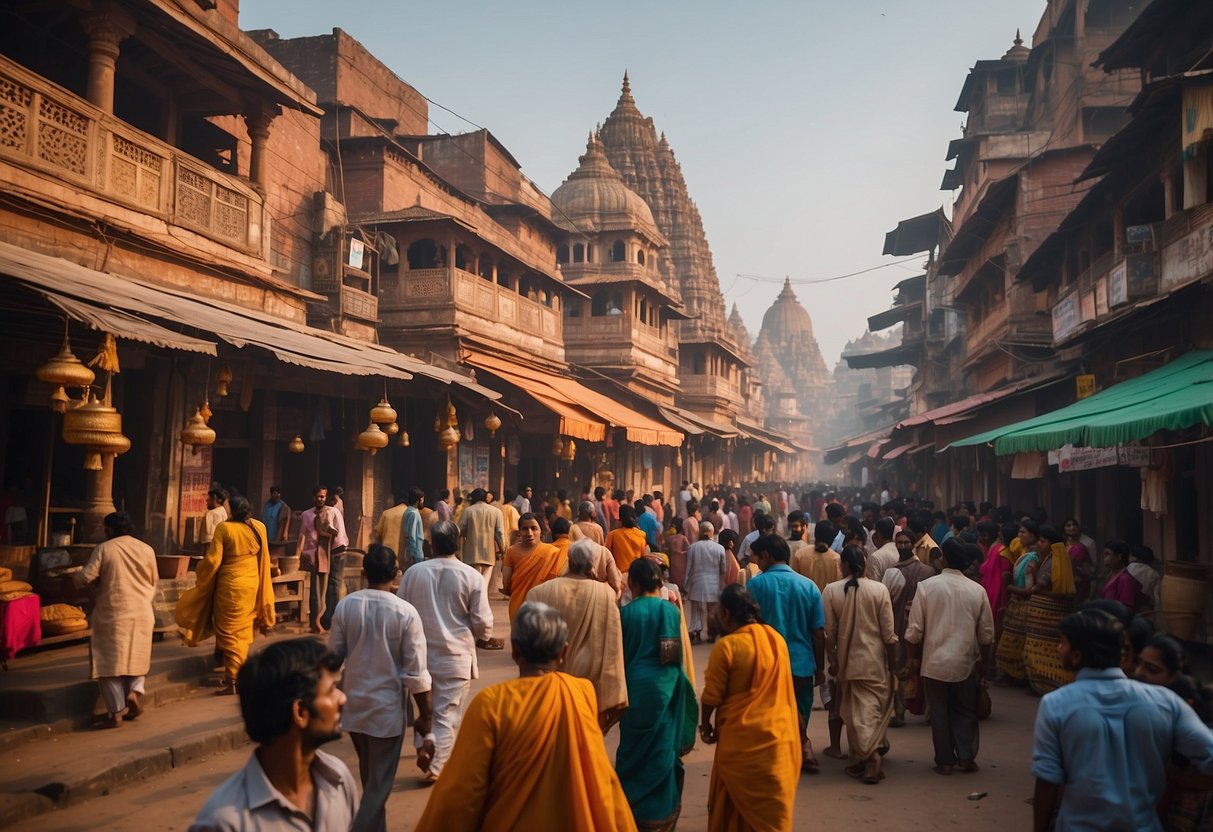
Banaras, also known as Varanasi, is renowned for its blend of spiritual, historical, and artistic elements. The city’s architecture and art forms showcase its rich heritage and cultural significance.
Ghats of Varanasi
The ghats are the heart of Varanasi’s architecture. These steps leading to the Ganges are not only symbolic but also practical, allowing pilgrims to bathe in the holy river.
Among the 88 ghats, Manikarnika Ghat is famous for its cremation rituals, symbolizing the cycle of life and death. Dashashwamedh Ghat is a prominent spot for evening aarti ceremonies, attracting numerous visitors nightly. Assi Ghat is popular for its tranquility and its role in various cultural and religious events. The architecture of these ghats combines functional design with deep spiritual meaning.
Architectural Marvels
Varanasi is home to numerous architectural masterpieces. The Kathwala Temple is an excellent example with its ornate wooden carvings. Built by Raja of Nepal, this temple stands out for its intricate designs.
Ramnagar Fort, situated along the Ganges, showcases Mughal and Hindu architectural styles. Its intricate carvings and courtyards reflect the artistry of the bygone era. The Banaras Hindu University (BHU) is another significant site. Founded in 1916, BHU’s sprawling campus features a mixture of traditional and contemporary architectural elements, reflecting its status as an educational and cultural hub.
Artforms and Craftsmanship
The art scene in Varanasi is vibrant and diverse. Crafts like silk weaving are famous worldwide, with Banaras silk sarees being a prized possession. Artisans also produce delicate items like wooden toys, brassware, and religious icons.
Paintings in Varanasi are rich in spiritual themes. The city’s miniature paintings often depict scenes from Hindu mythology. Local markets are filled with artworks that range from traditional to modern, often reflecting the city’s unique cultural narratives. The craftsmanship seen here is a testament to Varanasi’s enduring artistic legacy.
By featuring the ghats, architectural gems like Kathwala Temple and Ramnagar Fort, and the unique crafts and paintings, this section highlights the indispensable role of architecture and arts in the cultural fabric of Varanasi.
Economic and Social Fabric
Banaras, known for its vibrant culture, plays a crucial role in various sectors. Key areas include the textile industry with its famed Banarasi sarees, esteemed educational institutions like Banaras Hindu University, and the livelihoods of local people tied to commerce and tourism.
Textile Industry
The textile industry in Banaras is famed for producing Banarasi sarees, which are made from fine silk. These sarees are known for their intricate designs and gold or silver brocade, making them highly sought after both locally and globally.
The silk trade in this area supports numerous families and craftsmen. Traditional handloom weaving is a significant part of the local culture and the economy, employing many artisans. This sector also draws tourists who are interested in purchasing authentic Banarasi sarees and witnessing their creation.
Educational Institutions
Banaras is home to the Banaras Hindu University (BHU), one of the largest residential universities in Asia. BHU attracts students from various parts of India and abroad, fostering a diverse academic environment.
This institution contributes significantly to the local economy by generating employment and attracting commerce related to student needs. It also plays a pivotal role in the societal fabric of Banaras by offering cultural and academic exchange events that involve the local community. The university’s presence has also led to growth in other educational services and businesses around the area.
Local Livelihoods
Local livelihoods in Banaras are intricately tied to commerce and tourism. Many locals work in shops, restaurants, and as guides, benefiting from the steady influx of visitors. Key attractions like Brijrama Palace not only draw tourists but also provide jobs to locals.
Street vendors and small-scale business owners rely heavily on the daily foot traffic from tourists and pilgrims. Craft markets offer locally made goods, which help sustain traditional arts and crafts. Additionally, tourism has led to the development of infrastructure and services that enhance the quality of life for residents.
Tour Tourism and Travel Information
Banaras offers a rich array of accommodations, various transport options, and essential tips that ensure a smooth visit. A well-planned trip can make for a memorable experience.
Accommodations
Visitors to Banaras can choose from numerous hotels, guesthouses, and hostels. Many hotels, such as those listed on Tripadvisor, offer riverside views of the Ganges. Some popular choices include luxury hotels and budget-friendly options.
Certain places offer unique experiences like heritage stays, providing an authentic feel of the city. Advance booking is recommended, especially during the peak tourist seasons, to ensure availability and preferred lodging quality.
Transportation Options
Reaching Banaras is convenient with multiple transportation options. The city has a well-connected airport with flights to major cities. For those preferring trains, Varanasi Junction and Cantt stations serve as major hubs.
Local transport includes auto-rickshaws, cycle rickshaws, and buses. Boat rides on the Ganges offer a serene way to witness daily life and rituals. Each mode ensures you can explore the city efficiently and comfortably.
Travel Tips
Travelers should be mindful of local customs and dress codes, especially when visiting temples. It’s advised to carry bottled water and stay hydrated, as the climate can be hot and humid.
Morning and evening boat rides for the Ganga Aarti ceremony are highly recommended. Bargaining is common, so negotiating prices for rickshaw rides or market shopping can help save money. Being vigilant about personal belongings ensures a hassle-free and enjoyable visit.
Religious Significance and Pilgrimage
Banaras, also known as Varanasi, is a spiritual epicenter for multiple religions. Its holy sites, ancient temples, and significant Buddhist artifacts attract millions of devotees and curious travelers every year.
Hindu Pilgrimage Circuit
Varanasi is paramount in the Hindu faith. Hindus believe that bathing in the river Ganges here can cleanse one of all sins and aid in attaining moksha, or liberation. The Dashashwamedh Ghat, one of the most important ghats, hosts nightly Ganga Aarti ceremonies.
The New Vishwanath Temple stands as a modern marvel dedicated to Lord Shiva. Located within the campus of Banaras Hindu University, the temple is famous for its serene environment and impressive architecture.
Sankat Mochan Hanuman Temple, another significant site, is dedicated to Lord Hanuman. Pilgrims visit to seek blessings and divine help to overcome adversities. These temples, among others, form a vital part of the city’s spiritual landscape.
Buddhist Sites
Varanasi is home to Sarnath, where Lord Buddha gave his first sermon after attaining enlightenment. The Dhamek Stupa, built in 500 CE, marks this sacred spot.
The Chaukhandi Stupa, another key site, commemorates where Buddha first met his initial disciples. These stupas serve as powerful reminders of Buddhism’s deep-rooted history in the area.
Visitors can also explore the Sarnath Museum which preserves invaluable Buddhist artifacts, including the Ashoka Pillar’s original lion capital, India’s national emblem.
Other Religious Attractions
The city’s Tibetan Temple attracts those interested in Tibetan culture and spirituality. It showcases Tibetan art and architecture and serves as a peaceful retreat for meditation and reflection.
Varanasi also houses several smaller, yet significant, Jain and Sikh shrines. These religious sites contribute to the city’s rich tapestry of beliefs and practices, underscoring its diverse cultural and spiritual heritage.
Overall, Banaras stands as a beacon of spirituality, embracing a multitude of faiths and offering a unique pilgrimage experience to all who visit.
Environmental Aspects
The Ganges River plays a crucial role in Banaras, influencing its ecosystem, and the city is making strides in sustainability and conservation. Yet, challenges persist in preserving this natural heritage.
River Ecosystem
The River Ganges is central to Banaras, providing water, supporting biodiversity, and sustaining local agriculture. Its ecosystem includes various fish species, birds, and plants, which depend on the river’s health. The river also holds cultural and spiritual significance, attracting numerous pilgrims annually.
Water quality remains a concern due to pollution from industrial waste and sewage. Efforts are in place to monitor and improve water quality, crucial for maintaining the river’s health and the city’s sustainability. Rivers are vital for Banaras’ environment and need constant attention.
Preservation Efforts
Significant efforts focus on cleaning and preserving the Ganges. Initiatives like the Namami Gange program aim to reduce pollution and revitalize the river. Enhanced sewage treatment plants and better waste management practices have been introduced to prevent contaminants from entering the river.
Projects targeting the reduction of pesticide use in agriculture near the river improve overall water quality. Green practices in Banaras aim to protect natural resources and support the sustainability of the Ganges. Sustainable tourism practices are encouraged, promoting eco-friendly approaches among visitors and residents.
Challenges
Despite ongoing efforts, challenges in environmental preservation persist. Industrial pollution continues to affect the Ganges, with waste discharge from factories remaining a serious issue. Urbanization and population growth put additional pressure on the river, leading to increased waste and water usage.
Coordination between different stakeholders, including local authorities, industries, and the public, is often lacking, making it difficult to implement effective preservation strategies consistently. Addressing these challenges requires combined efforts and strong policies to ensure the sustainability of Banaras’ environment, particularly the vital Ganges River.
In summary, Banaras faces significant challenges in balancing development and sustainability, but continued efforts and coordinated actions hold promise for a healthier environment.
Frequently Asked Questions
Varanasi is rich with cultural and historical sites, offering various attractions and family-friendly activities. Knowing the best times to visit and how to make the most of your stay can enhance your experience.
What are the top tourist attractions to visit in Varanasi?
One key attraction is the Dashashwamedh Ghat, known for its evening Ganga Aarti. Banaras Hindu University, founded in 1916, is another highlight, sprawled over 1300 acres. The Parshvanath Jain Temple is also notable for its religious significance.
How can one spend a single day touring the most significant sites in Varanasi?
Start with a morning boat ride on the Ganges to witness the spiritual rituals. Visit Kashi Vishwanath Temple to experience religious fervor. In the evening, attend the Ganga Aarti at Dashashwamedh Ghat. Include a quick tour of Banaras Hindu University and explore its expansive campus.
Which package tours are recommended for experiencing Varanasi’s culture and history?
Several tour operators offer comprehensive packages. Look for those that include guided visits to major ghats, temples, Sarnath (where Buddha gave his first sermon), and local bazaars. These tours often provide insights into Varanasi’s rich history and cultural practices, making the experience more enriching.
What family-friendly activities are available for visitors in Varanasi?
Family-friendly activities in Varanasi include boat rides on the Ganges, visiting the Banaras Hindu University, and exploring the local markets for arts and crafts. Children might enjoy stories about the city’s historical and mythological significance, making educational tours to temples and museums worthwhile.
During which season is a visit to Varanasi most enjoyable?
The ideal time to visit Varanasi is during the winter months, from November to February. The weather is pleasant and suitable for exploring the city. Avoid the summer months, as temperatures can be exceedingly high and may limit outdoor activities.
How long should a typical itinerary be to cover the highlights of Varanasi?
A 2-day itinerary is often sufficient to cover Varanasi’s main attractions. This includes visiting major temples, ghats, and educational institutions like Banaras Hindu University. For those with more time, a 3-4 day stay allows for a more relaxed exploration, including visits to nearby Sarnath.




















